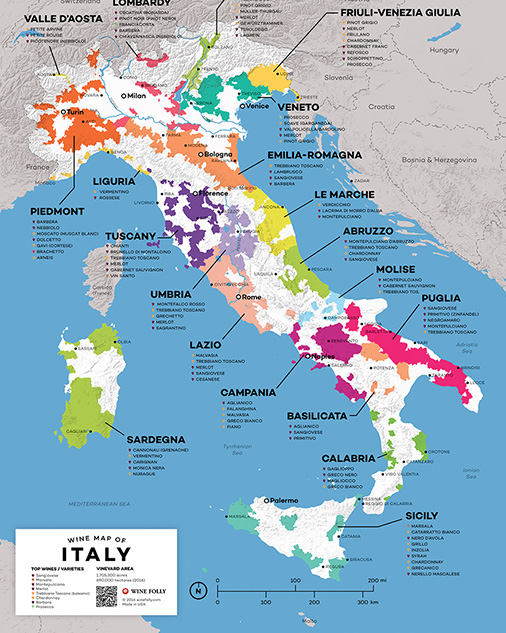

The sparkling wine is called Franciacorta and is made with Pinot Noir, Chardonnay and Pinot Blanc grapes in the same style as Champagne. Lombardy also produces some great Pinot Noir (they call it Pinot Nero) especially around Oltrepò Pavese. Nebbiolo is the red wine produced here but it’s called Chiavennasca it’s lighter and more ‘pinot’-like than its Piemontese sister. Valtellina is within Lombardy, close to Lake Como. Now there are several outstanding off-dry to totally dry Lambruscos from Emilia-Romagna.Ĭheck out Pinot Nero and Sparkling wines from Lombardy. Lambrusco has long been thought of as a cheap sweet fruity wine. Want more in-depth info? Read the essential guide onĮat the cheese from Parma and drink Lambrusco. Besides just the great Nebbiolo wines of Barolo, the region is also home to Moscato d’Asti and the underdog varietal: Dolcetto Nebbiolo is a grape with high tannin and pale color that has long been famous for its bristling acidity and high tannin. Try red wines and Moscato d’Asti from this area. For white wines in this region, keep in mind that Trebbiano is Italy’s most produced white grape and Vermentino has quite a few taste similarities to Sauvignon Blanc. When Sangiovese became the required major grape in Chianti during the 1970’s, the other noble grapes (Cab and Merlot) ended up creating a new style of wine: Super Tuscan. Tuscany is home to the Chianti region which is the most famous region for Sangiovese. Try red wines from Tuscany as well as a sweet wine called Vin Santo. Check out the article below on finding wines from Veneto. For white wines, Garganega is the white grape that makes Soave (‘swah-vay’), a wine that’s rich like Chardonnay. Besides the great red blends of Valpolicella made with Corvina, Rondinella and Molinara, there are also several fine Merlot-based IGT wines in this area. Veneto is known for the Valpolicella region which is known for producing Amarone della Valpolicella. Keep your eyes peeled for reds and a rich white wine called Soave. This removes all the grapes and wines produced for making vinegar and cooking wine and low quality table wine. The list of Italian wine regions is organized by highest volume of D.O.C. Wines made with non-Italian grapes like Merlot and Chardonnay often fall under this category (see Super Tuscans) Means “typical geographic indication” and is another type of quality assurance label for Italian wine. is the highest level of this assurance label.

Means “controlled designation of origin” and is a quality assurance label for Italian wine and cheese. That said, there are 3 major regions that produce the most high quality drinking wines and they are: Veneto, Tuscany and Piedmont.

Italy produces a huge amount of table wine, vermouth and cooking wines (such as some Marsala). Learn about the 20 Italian wine regions and which ones to try first when delving into Italian wines. See an easy to understand map of Italian wine regions and major wine varieties. rumors that over 2,000 different Italian grapes exist, but this might be a bit of an exaggeration– something Italians do well. The hardest part is learning all the different grape varieties.Īt the moment, there are about 350 official Italian wine varieties. Why? Well for one, the Italians use an esoteric wine labeling system, like the French. Italian wine is one of the most difficult regions to get to know. Both are screenshots from Adobe Acrobat.GREATITALY can help you find the best Italian wines. Here's a part of San Juan, Argentina, just north of Mendoza at 200% zoom.
#WINE MAPS OF ITALY FREE#
Although we're comparing only the digital editions, it gives a good overview of the differences between our maps.ġFrance, Italy and Spain each have a separate IGP level wine mapģ Wine Map of Sicily - Digital Edition - Free
#WINE MAPS OF ITALY FULL#
Here's a comparison of our Wine Maps of the World - Digital Edition with Wine Folly's full set of digital maps. We believe that our wine maps are the finest in the world, but obviously, we may be a little biased!


 0 kommentar(er)
0 kommentar(er)
